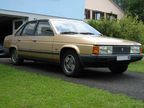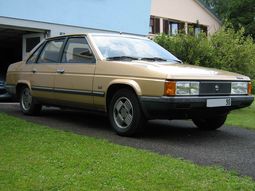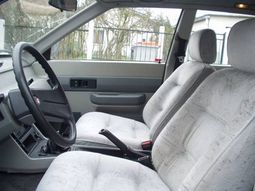The History Of Talbot Tagora

The Talbot Tagora is an executive car developed by Chrysler Europe and produced by Peugeot Société Anonyme (PSA). The Tagora was marketed under the Talbot marque after PSA took over Chrysler's European operations in 1979. PSA presented the first production vehicle in 1980 and launched it commercially in 1981. The Tagora fell far short of sales expectations, and PSA cancelled the model only two years later. Fewer than 20,000 Tagoras were ever built, all of them at the former Simca factory in the Poissy commune near Paris, France.
Chrysler Europe began the development of the Tagora in 1976, under the code name C9, with the goal of replacing the unsuccessful Chrysler 180 series. Following the same development pattern as with the Horizon and Alpine models, the responsibility for the Tagora's technical development remained in France, while the styling was devised at Chrysler's design centre in the United Kingdom. An early proposal for the name of the car was "Simca 2000".
Design
The original C9 prototype was a modern-styled saloon with a low beltline, ample glazing and a generous interior made possible by the rather large wheelbase. The British design team initially proposed some stylistic features inspired by the Citroën SM, including a front glass panel between the headlights to accommodate the license plate, round front wheelarches and rear fender skirts. However, Chrysler management in the United States deemed these features too extravagant, so the design of the C9 became more conventional: front and rear wheelarches were squared off and the skirts lost, and the license plate was placed on the front bumper as on most cars. To better balance the rather tall silhouette, the beltline was raised. Over the course of development, the C9 also lost its vertical taillights in favour of more "fashionable" horizontal ones.
Engine dilemma
The main competitors in the executive vehicle market offered engines bigger than the biggest two-litre straight-4 used by Chrysler Europe, and a six-cylinder engine was generally expected. Consequently, the company had to seek a new engine for the Tagora. One candidate was the Mitsubishi straight-6, but it proved unsuitable for a car of this class. The other proposal was the Douvrin V6 engine (the "PRV"), a joint development of PSA, Renault and Volvo. Since the Tagora would be in direct competition with PSA models that used the PRV, it seemed unlikely that Chrysler would be able to procure that engine.
Sales projections
Chrysler Corporation approved the development of the model on the assumption that Chrysler Europe would sell 60,000 C9s per year, which translated into a projected 5 percent share of the executive car market. This estimate seemed achievable because Chrysler had a 7 percent market share in Europe overall. The projected sales would have covered the car's tooling costs, with the development costs accounted for separately, as part of an independent annual budget.
PSA takeover
During the development of the C9, the management of the bankruptcy-threatened Chrysler Corporation decided to divest itself of its debt-ridden European operations. The buyer was the French PSA Group, formed in 1976 after Peugeot took over Citroën. The deal was finalized in 1978, with the buyer paying a mere $1 for the entirety of Chrysler Europe and its obligations. The take-over was effective as of 1 January 1979.
While the C9 project was well advanced, PSA already had a rather crowded lineup in the large vehicle segment, including the legendary Citroën CX, the slow-selling Peugeot 604 and the newly-launched Peugeot 505. Nevertheless, PSA decided to move forward with the C9 project, making a few significant changes that enabled the use of their own parts. The Simca double wishbone front suspension gave way to MacPherson struts adopted from the Peugeot 505 and 604, and the rear axle was replaced with that of the 505, much narrower than the one originally planned, as it was designed with respect to the 505 body width. The C9 front end was extended to accommodate the optional PRV engine: now that the model belonged to PSA, using the PRV presented no problems.
Following the renaming of Chrysler Europe's models to the Talbot marque, the C9 was christened the Talbot Tagora, and the first batch of cars rolled out of the former Simca plant in Poissy in 1980. The same year, PSA presented the Tagora at the Salon de l'Automobile in Paris. Following a hands-on demonstration of the model to the press in Morocco in March 1981, the car went on sale in France in April and in the United Kingdom in May. The British billboard advertising campaign boasted "The new Talbot Tagora. Luxury and performance redefined."
The Tagora was priced to overlap with high-end Peugeot 505s and low-end Citroën CXs, while slotting in beneath the Peugeot 604. Its pricing was also comparable to the Renault 20/ 30 and Ford Granada. (The Tagora was in the 20,000–30,000 Deutschmark bracket in Germany.) The initial production run in 1981 (combined with some pre-production runs from 1980) was only one quarter of Chrysler's initial projections. Sales proved insufficient even for this production level, and production continued to sharply decline throughout 1982 and 1983, prompting PSA to cancel the model altogether. By the time the Tagora met its fate, only about 20,000 had been built; by comparison, over 116,000 Peugeot 505s and 74,000 Citroën CXs were made in 1981 alone.
As with most large cars of its time, the Tagora was a rear-wheel drive vehicle, with a longitudinally-mounted engine. There were three engine choices, mated to four- and five-speed manual transmissions or an optional three-speed automatic in the case of the four-cylinder engines.
The available models were:
- 2.2L (2155cc) Type 180 OHC I4, double-barrel Solex carburetor, 115PS (85kW), 184N·m (136ft·lbf)
- 2.3L (2304cc) XD2S OHV turbodiesel I4, 80PS (59kW), 188N·m (139ft·lbf)
- 2.7L (2664cc) PRV OHC V6, two triple-barrel Weber carburetors, 166PS (122kW), 234N·m (173ft·lbf)
The Tagora Présidence was a concept car designed by stylist Sunny Atri at the Talbot design studio in Whitley, Coventry. The concept was created to generate interest in employing high-end Tagoras as chauffeur-driven limousines by users such as business executives and government officials. The donor model for the Présidence was the 2.6 SX, which had an interior appointed with Connolly Leather upholstery and real brass, plus a host of electronics including a telephone, dictaphone, text-message receiver, and television with VCR. Originally valued at £25,000, the Présidence now resides at a car museum in Poissy.
Market situation and image
In terms of engineering, the Tagora had no major flaws (except perhaps for the poor cabin ventilation). The 1979 energy crisis, however, dealt a blow to the European automotive market: the large car segment contracted significantly, making Chrysler's initial sales projections unrealistic. The Tagora was ultimately launched under the Talbot brand, which was relatively unestablished in the marketplace and had a questionable pedigree, which was an unfavorable trait in the executive car market ruled by established names like the Ford Granada.
Design
As the British automobile magazine What Car? opined, the Tagora "has such a complete blandness of style as to disqualify it instantly in a market where character and status count for so much." The design of the Tagora was focused on practicality, providing exceptional cabin space at the expense of style. The loss of some of the original design elements at the hands of Chrysler left the Tagora rather featureless. The steep windshield formed a quite strange angle with the relatively short, wedge-shaped bonnet. The car was wider and taller than most of its competitors, and buyers were unaccustomed to such proportions. The PSA-sourced axles had very narrow tracks relative to the width of the body, which provided an awkward look, especially at the rear. Nor did the plain, plastic dashboard stir enthusiasm among reviewers and prospective customers.
From Wikipedia, the free encyclopedia
More About Talbot Tagora



|